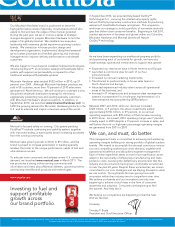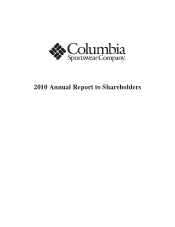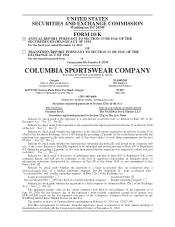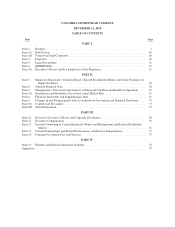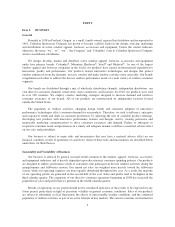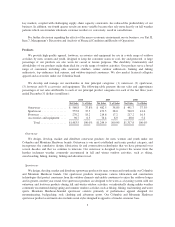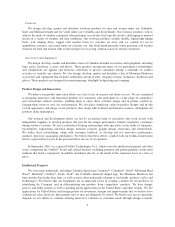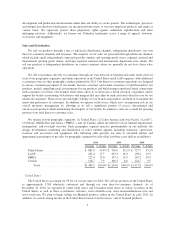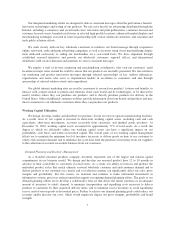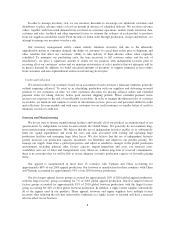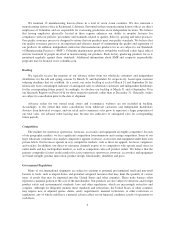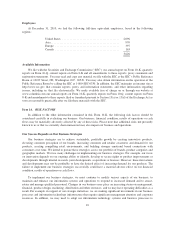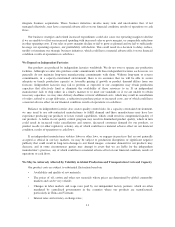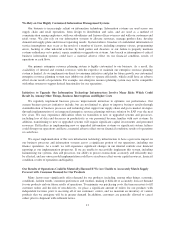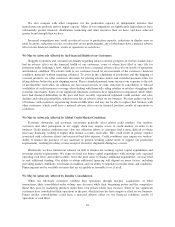Columbia Sportswear 2010 Annual Report Download - page 14
Download and view the complete annual report
Please find page 14 of the 2010 Columbia Sportswear annual report below. You can navigate through the pages in the report by either clicking on the pages listed below, or by using the keyword search tool below to find specific information within the annual report.In order to manage inventory risk, we use incentive discounts to encourage our wholesale customers and
distributors to place advance orders at least six months in advance of scheduled delivery. We use those advance
orders, together with forecasted demand from our direct-to-consumer operations, market trends, historical data,
customer and sales feedback and other important factors to estimate the volumes of each product to purchase
from our suppliers around the world. From the time of initial order through production, receipt and delivery, we
attempt to manage our inventory to reduce risk.
Our inventory management efforts cannot entirely eliminate inventory risk due to the inherently
unpredictable nature of consumer demand, the ability of customers to cancel their orders prior to shipment, and
other variables that affect our customers’ ability to take delivery of their advance orders when originally
scheduled. To minimize our purchasing costs, the time necessary to fill customer orders and the risk of
non-delivery, we place a significant amount of orders for our products with independent factories prior to
receiving all of our customers’ orders and we maintain an inventory of select products that we anticipate will be
in greater demand. In addition, we build calculated amounts of inventory to support estimated at-once orders
from customers and auto-replenishment orders on certain long-lived styles.
Credit and Collection
We extend credit to our customers based on an assessment of each customer’s financial condition, generally
without requiring collateral. To assist us in scheduling production with our suppliers and delivering seasonal
products to our customers on time, we offer customers discounts for placing advance orders and extended
payment terms for taking delivery before peak seasonal shipping periods. These extended payment terms
increase our exposure to the risk of uncollectible receivables. In order to manage the inherent risks of customer
receivables, we maintain and continue to invest in information systems, processes and personnel skilled in credit
and collections. In some markets and with some customers we use credit insurance or standby letters of credit to
minimize our risk of credit loss.
Sourcing and Manufacturing
We do not own or operate manufacturing facilities and virtually all of our products are manufactured to our
specifications by independent factories located outside the United States. We generally do not maintain long-
term manufacturing commitments. We believe that the use of independent factories enables us to substantially
limit our capital expenditures and avoid the costs and risks associated with owning and operating large
production facilities and managing large labor forces. We also believe that the use of independent factories
greatly increases our production capacity, maximizes our flexibility and improves our product pricing. We
manage our supply chain from a global perspective and adjust as needed to changes in the global production
environment, including political risks, factory capacity, import limitations and costs, raw material costs,
availability and cost of labor and transportation costs. However, without long-term or reserved commitments,
there is no assurance that we will be able to secure adequate or timely production capacity or favorable pricing
terms.
Our apparel is manufactured in more than 13 countries with Vietnam and China accounting for
approximately 68% of our 2010 apparel production. Our footwear is manufactured in three countries, with China
and Vietnam accounting for approximately 93% of our 2010 footwear production.
Our five largest apparel factory groups accounted for approximately 20% of 2010 global apparel production,
with the largest factory group accounting for 7% of 2010 global apparel production. Our five largest footwear
factory groups accounted for approximately 81% of 2010 global footwear production, with the largest factory
group accounting for 34% of 2010 global footwear production. In addition, a single vendor supplies substantially
all of the zippers used in our products. These apparel, footwear and zipper suppliers have multiple factory
locations, thus reducing the risk that unfavorable conditions at a single factory or location will have a material
adverse effect on our business.
8


